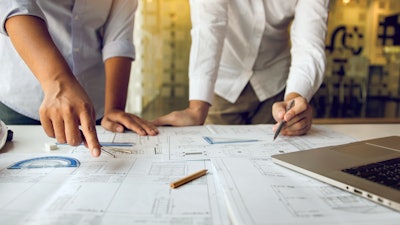
So, you want to open a brand-new facility but you’re not quite sure what’s all involved in the process. Know this: from conception to delivery, your baby is going to be several years in the making.
AB asked architects to walk us through the various stages, how long you can expect them to take and how far in advance of your grand opening each should occur to keep everything on schedule. Naturally, each firm has its own approach, but general concepts emerge that can be placed on a timeline for an average-sized multiuse facility accommodating fitness, aquatics, walking/jogging, court sports and community gathering in approximately 100,000 square feet and on a budget inside $100 million.
The time stamps provided here are estimates based on several different opinions, and are in no way etched in stone. No two projects are alike. If anything, our hypothetical project may err on the side of timeframe expansiveness.
“The majority of our clients typically will begin projects with challenging schedules in place,” says MJM Architecture & Design partner Ted Watson. “Sometimes this is due to inexperience with design and construction. More often, the client will understand the time needed but will strategically provide aggressive schedules to meet internal stakeholder goals — September hockey, the start of a school year — or to ensure perceived lower costs through a faster schedule, or to advance funding or donor goals by providing a far more optimistic schedule than is realistic. These are often very politically driven decisions.”
Here, then, is a general overview of what to expect and (roughly) when.
Assessing needs, 82 to 85 months out, one-to-three-month duration
The realization that what you offer your constituents is falling short of expectations — if you offer a particular facility type in the first place — is where dreams are born and the process truly begins. However, this starting point is a bit fluid. Desire for a new facility can drag on for years before any action is taken, but a formal look at needs can last one to three months when given its due.
“Your facility is tired and overcrowded and your users complain about the lack of air movement and old fitness equipment. Your patrons start hinting about the need for a new facility or suggesting they might start using another facility across town,” says Erik Kocher, a principal at Hastings+Chivetta Architects. “It’s time to start talking with your organization’s leadership about funding a feasibility study and starting down the path to your own grand opening.”
Hiring a design consultant, 74 months out, one-month duration
To further address how to best meet user needs with programming specifics, a design consultant may be introduced to the early planning stages.
“After the needs assessment, an institution then begins to research the possible design firms that can help them build on their original assessment by defining building program, evaluating potential sites and establishing conceptual budget numbers,” says Jim Gabel, vice president of CannonDesign. “This can often be done directly without the need for an official RFQ/RFP process.”
“The visioning stage is so critical,” Dewberry associate principal Tracy Coker says. “It’s an important phase of the project in understanding the organization and its driving principles. This stage often gets short-circuited, or owners don’t want to pay architects for this time, but visioning sets the framework of all the driving principles, and guides the team from beginning to end.”
Studying feasibility, 73 months out, three-month duration
A feasibility study typically includes stakeholder interviews, campus- or community-wide online surveys, market studies, revenue and expense projections, site selection and facility programming conversations, adjacency diagrams (simple building plans), room data sheets and preliminary cost estimates, according to Kocher, who adds that the process commonly establishes a mission statement, project goals and objectives, and a prioritization of desired building components.
According to Dewberry’s Coker, the feasibility study process informs the initial stakeholder vision where limitations such as available appropriate properties, budgeted funds and operational capacity may serve to collectively refine project priorities and desired outcomes.
She offers one caveat. “A common mistake is having too many stakeholders with disconnected goals,” Coker says. “This can really slow down the critical need for a full design process in the early stages. Once you start backtracking to bring stakeholders to consensus, something has to give, and more often than not, it’s the schedule. Delayed schedules add cost, extend construction and frustrate everyone.”
Advanced planning, 70 months out, six-month duration
Advanced planning, sometimes referred to as conceptual design, takes information gathered during the feasibility stage to develop a more detailed and realistic project perspective. The team expands beyond the architect to include consultants with expertise in mechanical and electrical systems, plumbing, fire protection, and structural and civil engineering. Landscape and aquatics consultants may also be incorporated as needed.
“Conceptual-level plans, a site plan, elevations and 3D renderings are developed, along with architectural and engineering narratives, a schedule, and construction and total project costs,” Kocher says. “The graphics created during this phase often become fundraising material used to excite potential voters or donors about your project.”
Fundraising, 64 months out, 24-month duration
Architects agree that procuring the funds necessary to bring a project to the finish line is a years-long effort regardless of where it begins and ends within the overall sequence of events. Says Gabel, “This phase can be ambiguous and less defined in a timeline, but entails procuring funds from local, state, federal and private sources.”
On a college campus, raising funds often requires the passage of a student referendum to establish a new student fee. For a municipal, county or state project, it can require the vote of the people in a general election, the support and vote of local council members, or the approval of a state university’s board of trustees. In some cases, funding is approved at the state legislative level and project funds are appropriated. A final method of funding a new facility is through private, foundation or corporate gifts.
Architect selection, 40 months out, four-month duration
A request for qualification (RFQ) or a request for proposal (RFP) solicits information from prospective design firms and is often a month-long process. The client then spends another two months or so evaluating these and creating a shortlist of leading candidates to interview. For larger projects, the total process may take longer and involve reviewing the proposals of two dozen or more prospective firms, from which a handful ultimately are interviewed.
The winning firm is selected and a formal contract agreed upon. Further approvals may be required — from a city council or university’s board of trustees — before the architect can begin its work. “In some cases, the architect you select to complete advanced planning can be retained as your architect to move the project forward,” Kocher says. “However, some owners, municipalities and universities are required to select an architectural team from a new list of architects.”
Schematic design, 36 months out, three-month duration
With an architecture team in place, the building design can truly begin to take shape. During the schematic phase, a building’s room-by-room spatial planning is advanced, the site’s parking and landscaping are more carefully considered, as is the architectural approach to the building’s basic elements and scale. Says Watson, “The architecture will come into being in this phase, and it is the responsibility of the client and designers to ensure the design is expressive of the community’s values and goals.”
Design development, 33 months out, three-month duration
This phase defines the project even further, including drawings and outline specifications. The project’s size and character are established, and the architectural, structural, mechanical and electrical systems are described and documented. A detailed cost estimate is typically developed at the end of the design development phase and compared against available budget dollars. In other words, things are starting to lock in. Says Gabel, “The building and site design start to become more final with limited opportunity for revisions.”
Construction documents, 30 months out, three-month duration
Based on the approved design development documents, the project moves into the construction documents phase. During this phase, the drawings and specifications that contractors and sub-contractors use to bid the project are developed and finalized to prepare for the bidding process. “This is an intense and highly technical phase where coordination and accurate documentation are needed to ensure these contractual documents will allow for clear execution of the project,” Watson says.
Bidding, 27 months out, two-month duration
Once documents have been approved internally within the team and externally by any agencies whose approval is required, it’s time for contractors, subcontractors and suppliers to bid on the project. During this six-to-eight-week period, contractors can ask questions about the project and receive answers in the form of contract addenda. When a predetermined deadline arrives, bids are made public, and the successful bidder is awarded the project contract.
Construction, 25 months out, 24-month duration
“Now the fun really starts,” according to Kocher, who advises to be prepared for all sorts of variables. “Several factors can shorten or lengthen this timeline, including utility installation, bad soil conditions requiring remediation, hazardous material removal, supply chain delays, labor shortages and bad weather.”
“Changes in project leadership, a reprioritization of earlier goals, or unanticipated mitigating factors such as a global pandemic can also create the need for adjustment during a productive build phase,” adds Coker. “Ultimately, the completed facility, the driving motivation of this process and effort, is realized in its full form for the enjoyment of the end-users. A learning curve remains as the building operators learn how to best manage, maintain and leverage the features and systems incorporated during design.”
“This phase is often a trial by fire, particularly for the uninitiated, and can often seem like endless problem management, but it’s also the most transformative and rewarding,” Watson says. “There are constant cost and technical challenges that need to be addressed by the client, architect and contractors — ideally working together as a team throughout this phase. The wonderful outcome is to see the dream fully realized as it emerges from the potential of the site and the vision of the community. The project is substantially complete with the building inspector’s approval for occupancy, and there are often soft and hard openings at the end of this process.”
Grand opening
How do you celebrate an achievement that has demanded your attention for years? By taking a little more time to do it right, according to Kocher, who suggests asking several questions: Who’s invited? Who will be speaking? Will there a ribbon-cutting, a giveaway, food served? Is it indoors or outdoors, and will you host tours? “Remember, it takes weeks to plan a large party, so start early with those plans,” Kocher says. “Most important, be sure to adequately fund the event.”
Warranty review, UPON COMPLETION, 11-month duration
The excitement of opening the facility has waned a bit, but one more important step in the long process remains. A final review of any lingering issues with the new building and its operation needs to be addressed ahead of warranty expiration, with that 12-month clock starting to tick at the point of the project’s substantial completion.
It is also a great time for the facility’s architect to interview those who have interacted with it most over its initial 11 months of operation — namely, the operations staff — to assess what has and hasn’t worked well to date.
Watson’s number-one piece of advice: devote adequate time and attention to the front end of any project, when stakeholder vision meets design team expertise.
“Specifically, we find there is a cost-effectiveness and extremely high value in a robust needs assessment, the public and stakeholder engagement phase, and the concept and feasibility phases,” he says. “These are the parts of the process that ensure the project is meeting the needs and desires of the community most effectively, and that the dollars are spent in the right place to deliver the highest-value outcome for users. Building the right project to achieve the right goals is fundamental to success. Time needed to do this properly is far too often underestimated.”
Rare is the project that doesn’t encounter a bump or two — or five — in the road. But the process can be enlightening and ultimately rewarding if due diligence is paid in advance of each milestone marking the journey. It starts with a dream, and hopefully ends with the organization’s dream home — a facility that best meets users’ needs given the budget and time allowed.
“The most successful projects have owners with a very clear understanding of what they are trying to accomplish,” Coker says. “They know the ‘why,’ and the design team can follow that through the entire project. It’s harder to get derailed on the schedule when the goals are crystal clear.”





































